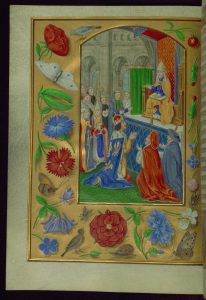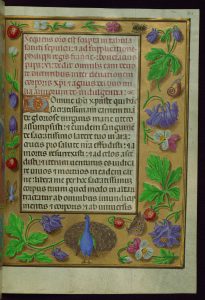The amount of time I’ve spent this semester on the Passion texts within the Hargett Hours seems at odds with my end-of-semester conclusion: Hargrett’s Passion material is unusual. We knew that by the end of Fall 2016, so the inability to properly answer why a year later makes it seem like I’ve been sitting by, twiddling my thumbs and beating my head against my desk.
While I’ve definitely done one of those things, it hasn’t been entirely in vain. When I say that Hargrett’s Passion material is unusual, I can now throw numbers at the statement to help make it stick.
Here’s the breakdown:
26/215 manuscripts contain the Hours of the Passion, 33/215 contain the Gospel of John’s account of the Passion, and one or more of the seven prayers from the Hargrett Hours appear in 43/215.
Of those 43 manuscripts, 22/43 contain prayer six, 21/43 contain prayer five, 17/43 contain prayer two, 12/43 contain prayer three, and none contain prayers one and four. To put that into perspective, the prayers individually appear in less than 10% of the manuscripts surveyed.
If a manuscript contains more than three prayers from Hargrett, it won’t contain either the Long Hours of the Passion or the Gospel of John’s Passion sequence. Not a single manuscript has an identical devotional sequence, or one equally dedicated to the Passion in length and focus.
Golly. Numbers, right?
There’s still work left to be done on the survey, so hopefully when everything resumes in Spring 2018 we’ll find that one mythical manuscript that has all of Hargrett’s Passion material.


Trucking along has brought its share of small wins. I spent most of October working on my conference paper for the South Atlantic Modern Language Association’s Undergraduate Research Conference (I only stuttered for a few minutes! Eight people came to the panel! All in all, a roaring success), and while I was prepping the power-point that accompanied the paper, I found a version of prayer six “Domine ihesu xpi qui hanc sacratissimam…” accompanied by an interesting rubric and miniature. I wrote about this at length, but long story short, Hargrett 838’s prayer is connected to Sainte-Chapelle through a convoluted historical anecdote that incorrectly attributes an indulgence to Boniface VI instead of Boniface VIII because of a strained relationship between Boniface VIII and the French crown. After finding the rubric in Walters W. 441, I went back through the survey to account for rubrics attached to prayer six, and found ten similar versions; the misdirection seems to be intentional. I never would have found that connection if I hadn’t been working on the SAMLA paper (and procrastinating, just a bit).
Hoping to capitalize on my luck, I pulled twenty samples of prayer six from the survey for a textual analysis, thinking there might be some kind of regional variation in the rubric or prayer that linked it, in some small way, to France. Alas, chaos prevailed. Most every prayer was different, with nothing to connect the appearance of the Boniface/Philippe rubric to certain variations in the text or to specific regions.
That relative disappointment brings us to the end of this semester, and while I don’t have the results I had hoped for, the pitfalls of Fall 2017 have armed me with a new set of rabbit holes to follow in the spring. The Boniface rubric highlights a need to investigate both the rubrics on their own as well as Sainte-Chapelle’s connection to the manuscript, which was established in Fall 2016 by the project’s Calendar and Codicology groups. With any luck, some combination of Sainte-Chapelle and the survey will produce promising results in Spring 2018.
But, until then, I’m going to be sleeping.
See you soon,
Katie